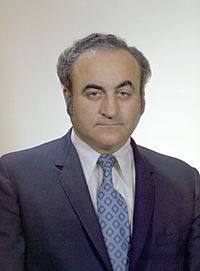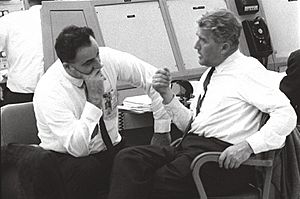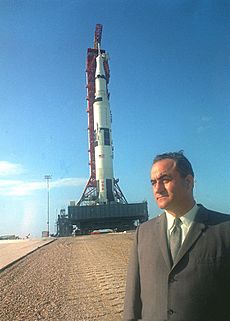Rocco Petrone facts for kids
Quick facts for kids
Rocco A. Petrone
|
|
|---|---|

Official NASA portrait
|
|
| Born |
Rocco Anthony Petrone
March 31, 1926 Amsterdam, New York, U.S.
|
| Died | August 24, 2006 (aged 80) |
| Education | |
| Occupation | Director of the Marshall Space Flight Center |
| Spouse(s) | Ruth Holley Petrone |
| Children | 4 |
Rocco Anthony Petrone (March 31, 1926 – August 24, 2006) was an American engineer and U.S. Army officer. He also became an important official at NASA. He helped lead many major space missions. From 1966 to 1969, he was the director of launch operations at NASA's Kennedy Space Center (KSC). Later, he directed the entire Apollo program from 1969 to 1973. He also served as the third director of NASA's Marshall Space Flight Center and as a top administrator for NASA.
Early Life and Military Service
Rocco Petrone was born in 1926. His parents were immigrants from Italy. He grew up in a Catholic family. He attended the United States Military Academy at West Point. While there, he played football as a defensive tackle. His team even won a national championship in 1945!
After graduating in 1946, he served in the U.S. Army in West Germany. He also earned a master's degree in mechanical engineering from the Massachusetts Institute of Technology (MIT). During his 20 years in the Army, Petrone helped develop the Redstone rocket. This was the first U.S. ballistic missile. It was also used to launch America's first astronauts, Alan Shepard and Gus Grissom, into space. He retired from the Army in 1966 as a lieutenant colonel.
Leading Space Missions at NASA
In 1960, Rocco Petrone began working with NASA. He was in charge of getting the huge Saturn V rockets ready for launch. He called the five months of preparation before each launch "five-month marathons." He oversaw the building of all the launch facilities for the Apollo program at Kennedy Space Center. This included Launch Complex 39, the Vehicle Assembly Building, and the Crawler-transporter. These facilities were later updated for the Space Shuttle missions.
After leaving the Army in 1966, he continued working for NASA as a civilian. In July 1966, he became the director of launch operations at KSC. This meant he was responsible for making sure rockets launched safely.
In September 1969, right after the amazing Apollo 11 mission landed humans on the Moon, Petrone was promoted. He became the director of the entire Apollo program at NASA Headquarters. In 1972, he also helped manage the joint space project between the U.S. and the Soviet Union, called the Apollo-Soyuz Test Project.

From 1973 to 1974, Petrone served as the director of the Marshall Space Flight Center. He was the first non-German person to hold this position, following famous rocket scientists like Wernher von Braun. During this time, NASA faced budget cuts.
In 1974, Petrone moved to NASA Headquarters. He became the NASA Associate Administrator. This was the third-highest position in the entire agency.
After NASA and Legacy
In 1975, Rocco Petrone retired from NASA. He then worked in other fields, including helping to find ways to recycle materials and energy from waste. In the 1980s, he worked for Rockwell International. This company built the Space Shuttle Orbiter. He eventually became the head of Rockwell's space transportation division.
Before the Space Shuttle Challenger was launched on mission STS-51-L, Petrone and his team noticed a lot of ice on the Orbiter. This was due to very cold weather. Petrone was worried the ice could damage the shuttle's heat shield during launch. He told his managers that Rockwell could not support the launch because of the ice. However, the ice was not the cause of the Space Shuttle Challenger disaster that tragically killed seven astronauts.
Rocco Petrone passed away on August 24, 2006, at the age of 80. In February 2022, NASA honored him by renaming the Launch Control Center in Florida. It is now called the "Rocco A. Petrone Launch Control Center."


